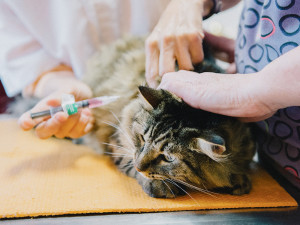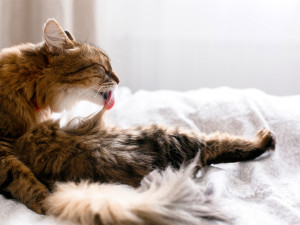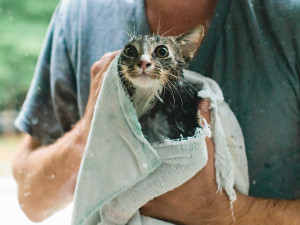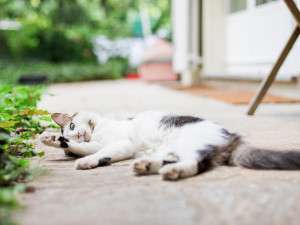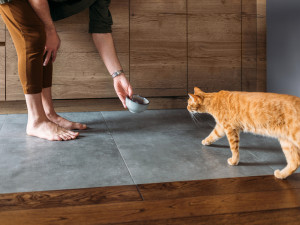The Best Way to Get Rid of Fleas On Cats, According to a Vet
Break the cycle before it gets worse... trust us
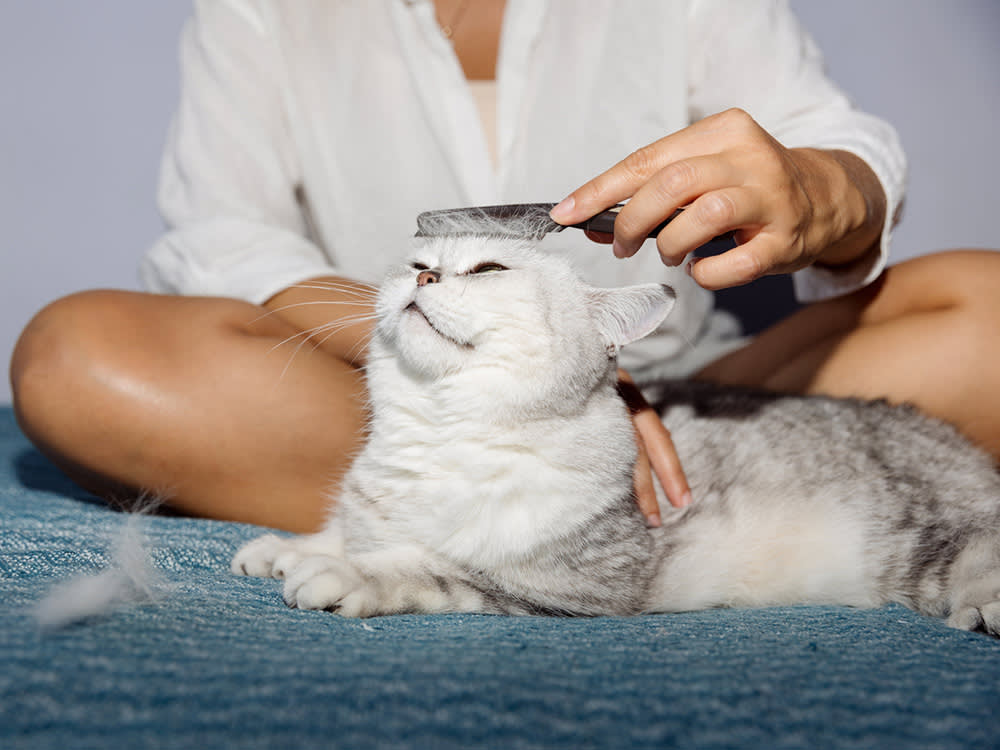
Share Article
Fleas sound like they are part of the premise for a horror movie: they’re tiny, they’re everywhere, they’re multiplying rapidly, and they’re feeding on your cat’s blood. The good news is that there are many very quick and effective ways to get rid of this particular villain. Pet parents sometimes think that indoor cats won’t get fleas because they aren’t o ut and about in the wild, but this is a myth. Cats can and do get fleas, even if they haven’t so much as waved a paw outside of the house. While some flea infestations are very obvious, others can be subtle, so it is important to keep fleas in mind for any cats who are having skin problems or seem itchy.
When it comes to treatment, there are loads of effective options and most work very quickly. If you discover a flea infestation on any one of your pets, you must treat the whole house; this includes treating all the pets in the home and doing a thorough cleaning of the environment to make sure to remove fleas from the floors and furniture, too. Lastly, fleas can carry other pesky parasites with them, so it is important to contact your vet if your pets have fleas and ensure they are treated for any other infections, too. The good news is that most cats recover very quickly from a flea infestation and will be feeling great in no time with the right treatment.
How do cats get fleas?
Determining how cats get fleas requires a basic understanding of the flea’s lifecycle. Fleas are known as ectoparasites, meaning they live on the outside of their hosts and use their host to meet their basic needs. Their food is the host’s blood, and they reproduce and lay eggs on their host. Fleas can have many different hosts, including cats and dogs, though different species of fleas often infect different animals. Flea eggs are very hardy; they fall off pets and contaminate the environment, surviving for up to two weeks before hatching. Once their ideal conditions are met, the eggs will hatch, and the larvae start to mature. The larvae eventually form a cocoon and develop into a pupae that is extremely hardy and resistant to freezing, drying and many forms of insecticide.
They can stay in this state for up to a year and then emerge as adults ready to start the whole cycle all over again. Cats can get fleas in a few different ways along this lifecycle. The first is that adult fleas jump directly on to them and get comfy. This most often happens outside where fleas are abundant, especially in the warm weather months. It can also happen in any environment where fleas are present, including a home that already has fleas from other pets or a shelter environment. Even if your cat doesn’t go outside, but your dog does, your dog might bring fleas into the house. The eggs and pupae can also be a source of new infections, so people may track them into a home on their clothes or shoes, or they could enter your home on other fabrics or materials.
What are the symptoms of fleas on cats?
The most common symptoms of fleas on cats include itchy skin, as well as signs of damage to their fur and skin from inflammation and scratching. Fleas tend to congregate along the lower back near the base of the tail, on the head, and on the belly, so cats will often bite and chew at the fur around these spots when they have fleas. They may be itchy all over, too. Some cats can have a more severe reaction to flea saliva and this can cause flea allergy dermatitisopens in new tab, an allergic form of itchiness, hair loss and inflamed skin. Common symptoms of fleas on cats include:
itchy skin, especially around the base of the tail and belly
patches of hair loss
scabs or bumps on the skin
scratching and/or biting at their fur
large areas of hair loss with signs of red, malodorous and/or infected skin if flea allergy dermatitis occurs
What do you do if your indoor cat has fleas?
If you’ve seen live fleas on your cat, you have a confirmed diagnosis of fleas. If your cat seems very itchy or has some areas of hair loss, you may need to investigate further to determine whether or not fleas are the problem.
You can part your cat’s fur all the way down to the skin to look for live fleas and/or ‘flea dirt’. Flea dirt is actually flea poo, and it looks like black dandruff. If you find some black flaky material on your cat, you can place it on a paper towel and wet it to see if it is flea dirt. Flea dirt will turn red when it is wet because their poo contains remnants of blood.
If you do not see any live fleas or obvious flea dirt, the next step is to comb your cat’s fur out with a flea comb. Flea combs are usually made of metal and have very fine teeth. When you comb out your cat with a flea comb, closely examine the fur that gets trapped in the comb for signs of live fleas and/or flea dirt. Sometimes only a small amount is present on your cat, and combing them out allows you to get a more thorough sample.
If you are still unsure if fleas are the problem, set up an appointment with your veterinarian because your cat’s skin issues may be caused by something else entirely. If you have confirmed that your cat has fleas, now it is time to come up with a treatment plan. Treatment should combine treating your cat, as well as all other pets in the home, even if you haven’t seen fleas on them.
The best flea treatments will combine multiple cat-safe ingredients to kill adult fleas, larvae and flea eggs. You will also need to clean the house thoroughly to remove fleas, cocoons and flea eggs from the environment to prevent reinfection.
What are the best home remedies for fleas on cats?
Home remedies are a good starting point to kill the live fleas on your cat, but this is not enough to completely rid your cat and your home of a flea infestation. It is very important to purchase a safe and effective medication as well to be sure to knock out all the life stages of the flea and ensure the fleas are gone for good.
Keep in mind the flea lifecycle: killing only the adult fleas will not get rid of the infestation because the eggs and pupae can survive in the environment just waiting to reinfect your kitty. Here are some things you can start with at home.
Bathe your cat
Bathe your cat with a safe and gentle shampoo to remove the live fleas. If you don’t have any cat-specific shampoo, you can even use a gentle dish soap, to get that initial bath out of the way. Just be sure to use a small amount of soap and rinse it off thoroughly because cats groom themselves meticulously, and you don’t want them ingesting lots of soap.
Comb your cat daily
That handy flea comb can also be helpful for removing adult fleas and flea eggs. Combing your cat’s fur out daily will reduce the number of fleas and eggs on your cat, as well as in the environment.
Thoroughly clean your home
This is a critical step in getting rid of fleas. Remember those eggs and pupae can be in the environment just waiting to start the cycle all over again so they need to be removed from carpets, furniture and bedding.
What is the best flea treatment for cats?
The best flea treatments for cats combine products that kill as many life stages of the fleas as possible. This means that the product will need to have an insecticidal ingredient to kill adult fleas as well as ingredients that can destroy eggs and/or larvae, often called Insect Growth Regulators, or IGRs.
To date, there are no products that can kill the pupae stage because the cocoon is so tough, so the environment needs to be thoroughly and repeatedly cleaned to remove as many cocoons as possible. It also means that your cat will need to stay on a routine preventative because any pupae that remain in the environment can hatch within a year’s time and start another infestation. Maintaining your cat and any other pets on a monthly preventative will protect them from reinfection.
What is the fastest way to get rid of fleas on a cat?
The fastest way to get rid of fleas is with an oral or topical flea medication that will kill adult fleas as well as eggs and/or larvae. Some products start working within hours. In order to completely rid your pets and home of fleas, you will need to follow up by thoroughly cleaning your home and putting all of your pets on regular flea preventatives.
Be sure to treat your cat with a product that is intended specifically for cats. There are some flea products intended for dogs that are toxic to cats, including those that contain permethrin, so never use these on your cat or in a home with cats. Some essential oils that are marketed as natural flea products can also be toxic to cats.
Do you need to clean your house if your cat has fleas?
Yes. For sure. Roll up your sleeves and get ready to go to battle against the fleas in your home. Here’s another gentle reminder about that flea lifecycle; those eggs and cocoons have evolved to withstand everything you can throw at them, so it is going to take a lot of elbow grease to clear them out.
Anything with fabric on it needs to be washed or discarded including furniture, pet beds and your own bedding. Spaces with carpet should be vacuumed frequently to remove as many fleas, eggs and cocoons from the area as possible. Ideally, have your carpets washed and cleaned, too. Hardwood floors should also be vacuumed and mopped to remove fleas that may be in the cracks of the floorboards.
Should you take your cat to the vet for fleas?
Fleas can carry other infectious bugsopens in new tab that can make your cat sick. This includes a form of tapeworm, an intestinal parasite, as well as species of Bartonella, Mycoplasma and/or Rickettsia. These infections can make your cat feel much sicker than a simple flea infestation, so it is important to contact your vet if you notice other signs including decreased appetite, vomiting, diarrhoea, lethargy, pale gums and/or difficulty breathing. Any cat with fleas should be treated for tapeworms because this is such a common secondary infection from the fleas.
This is because when cats are itchy, they are constantly biting and chewing at their fur and are very likely to accidentally eat some fleas, allowing the tapeworms to set up shop inside their digestive tract. Cats with severe flea infestations can also develop anaemia as a result of blood loss from the fleas feeding on their blood. This is especially common in kittens, as well as cats who are frail from other medical problems. If your cat seems to have a lot of fleas and/or is lethargic or has pale gums, it is very important to see a vet right away.
References:

Dr. Amy Fox, DVM
Amy Fox, DVM is a small animal veterinarian in New York City. A lifelong animal lover, Dr. Fox studied biology in college and then worked as a veterinary nurse before pursuing veterinary school at Cornell University. She has worked in many different settings including shelter medicine, emergency medicine, general practice, and animal cruelty and forensics. She is especially interested in nutrition, preventative medicine and care for senior pets. Dr. Fox also enjoys writing about veterinary medicine and teaching. In her free time she loves to cook, garden, and go for long runs.
Related articles
![Gray and white striped cat is scratching his ear]()
What’s Up With My Cat’s Skin?
Everything you need to know about cat allergies, according to three veterinary dermatologists
![cat wrapped in towel after bath]()
Self-Care Sunday For Cats
How to bathe a cat, step by step
![Siberian cat licking her paw outdoors.]()
What to Know About Tapeworms in Cats
What to look for and how to treat it (to be able to eat rice again)
![Orange cat relaxes in the garden.]()
What to Know About Fungal Skin Infections in Cats
Itchy and definitely not fun – here’s what to look out for
![Profile view of a man giving a cat food to eat]()
Why Is My New Cat Not Eating?
A veterinary nutritionist explains the causes, signs and treatment for how to increase their appetite

